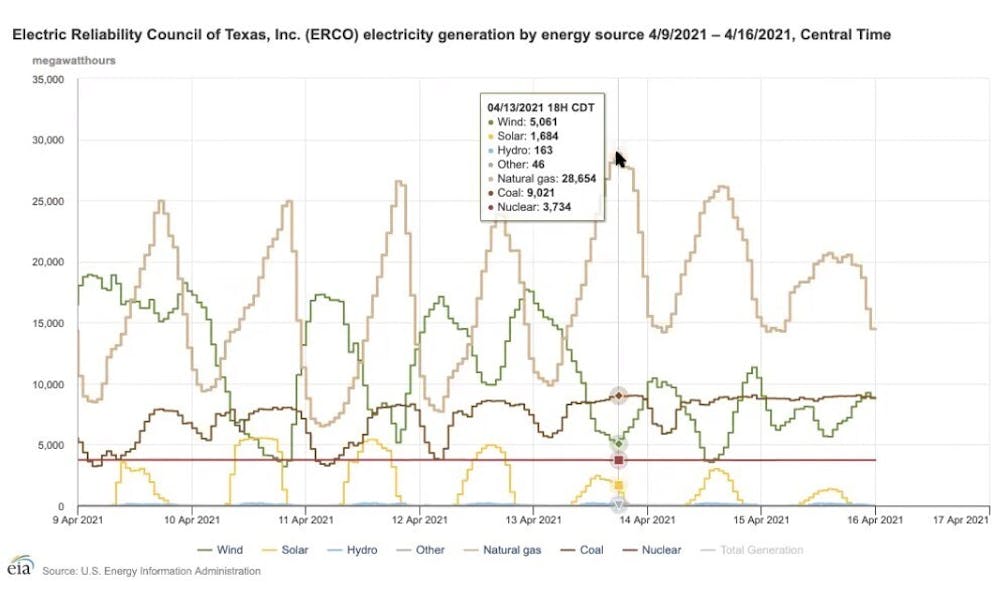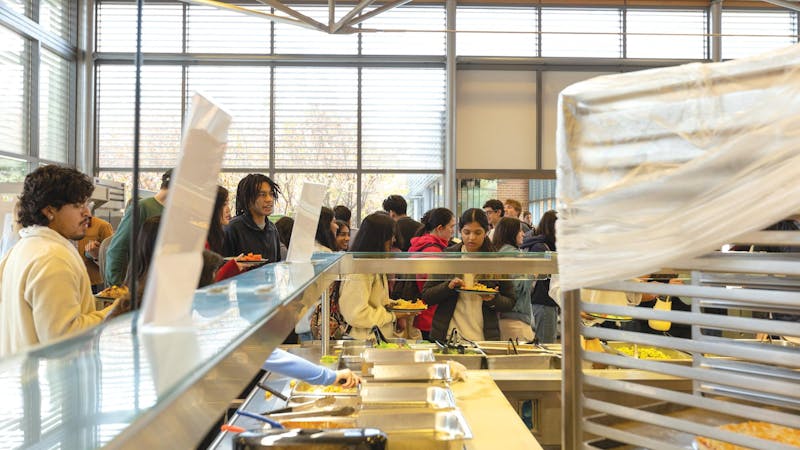The state of energy in Texas: A conversation with Daniel Cohan following ERCOT’s energy conservation appeal

On April 13, a mild spring afternoon, the Electric Reliability Council of Texas announced they may begin emergency operations and called for energy conservation from Texans. Four hours later, ERCOT ended the appeal, but questions about Texas’s energy situation remain. Since extreme weather and an ensuing power crisis struck the state over two months ago, many media outlets, including the Thresher, have gone to Rice civil and environmental engineering professor Daniel Cohan for an expert explanation. The Thresher caught up with Cohan for a follow-up conversation.
This interview has been condensed and edited for clarity.
Rice Thresher: I’d like to begin with the recent conservation request that ERCOT issued last Tuesday and ended later that night. Why did they do that?
Daniel Cohan: They've had an enormous amount of their gas, coal and nuclear plants down for maintenance. And so, even on a very mild day when air conditioner use wasn't high at all, they struggled to satisfy demand when it got cloudy and the wind slowed down. They had underpredicted how much demand there would be that day. The demand was actually pretty moderate, and the weather was mild. This isn't a season when you expect to hear conservation notices or really think about the electricity system at all.
Springtime is always the maintenance season for power plants in Texas. Normally there's a lull in power demand after heating needs die down from the winter. Power plants use this opportunity to conduct maintenance to prepare for the summer, the peak season, when our air conditioners are running most.
ERCOT has reported power plant outages at levels substantially above [those] last year or in a typical year ever since the February storm. We always have some plants down for outage, but the fact is that we've had [around] 33 gigawatts all down at the same time [recently] — much higher than usual.
“They underpredicted demand by that gap of 2,600 megawatts because it was a tiny bit hotter than they expected,” Cohan said.
RT: Demand for energy wasn’t very high last Tuesday. What was the problem?
DC: ERCOT made a plan to be ready for 65,000 megawatts on the hottest spring day. We haven't really gotten much above 50,000 megawatts all spring. The day that we had the problem, demand got up to around 48,800 megawatts. But they had only forecast 46,200, so their weather forecast was wrong. They underpredicted demand by that gap of 2,600 megawatts because it was a tiny bit hotter than they expected. But that shouldn't have been a problem. 48,000, we do that all the time and, and they are supposed to have planned for 65,000. The problem is they've let so many of their so-called “firm” power plants go down at the same time, that when they had this little unexpected gap [between supply and demand], power prices went through the roof. We don't pay that in our homes or apartments where we have fixed rates, but on the wholesale market, the prices jumped from about $20 a megawatt-hour up to $2,000 a megawatt-hour. That's why they told people to conserve: The power prices were becoming so tight and they were worried about not being able to meet this.
What's been very strange is that there [are] much less gas, and coal and nuclear that have been available than usual. ERCOT has, I think, 46,000 megawatts of gas capacity, but ever since the storm hit, we've never had more than 30,000 megawatts of gas operate … We have so much gas, coal and nuclear down for maintenance that coal was only able to get to 9,000 [megawatts], even though there's almost 14,000 [megawatts] of coal capacity; gas could only get to 28,000 [megawatts], even though we have 46,000 [megawatts] of gas capacity. It’s just the grid is really strained because we've got so many power plants down for outages all at the same time.
We've been pretending that only our wind and solar supply are variable. We know that it's not always sunny, and we know that it's not always windy, but Tuesday [last week] and February are two reminders that our gas, coal and nuclear supplies aren't fully reliable either — they go down during weather crises and they go down for maintenance, and when too many of them go down at once, we struggle to keep the lights on affordably.
RT: Can you talk about the state of the power grid in general?
DC: Our gas, coal and nuclear plants have all been struggling this year. They all had much less output than expected during the February storm, and all of them are still having a lot of outages today … The other big trend on the grid is that we've been adding wind and solar very, very quickly. The state has a lot of gas capacity but we haven't been adding any in recent years. Wind has grown: It took until 2002 to get to our first 1000 megawatts — or our first gigawatt — and then to eight [gigawatts] in 2008. It reached 25,000 last year and is expected to get to 36,000 by the end of this year and keep growing next year.
About solar, we used to have very little. It took us till 2017 to get our first gigawatt, but now, we're more than doubling solar this year alone. We're going to have a lot more solar come online before the summer starts, and it could really help us keep the lights on this summer. Right now we have about six gigawatts of solar capacity, but by the end of this year, we should have nearly 12 gigawatts of solar capacity. This means solar farms. They don't keep track of people like me who have solar on our rooftops — that kind of factors in as less demand. They're putting solar onto the grid. We're literally going to have that triple this year and then double again next year. So help is on the way.
As we have more and more wind and solar [power], batteries are growing very fast. Still, even by the end of this year, we're only going to have 1,651 megawatts of batteries, compared to 12,000 [megawatts] of solar and 36,000 [megawatts] of wind. There are nowhere near enough batteries to balance the ups and downs of wind or solar. It'll help to have battery storage to smooth things out, but it's not enough to replace a single coal plant going down or lots of wind and solar. It would be nowhere near replacing the 30,000 [megawatts] of natural gas that went out in the February storm. It would be prohibitively expensive to try to build enough batteries to fully back up a power grid. The challenge of the electricity grid every second of every day is to keep a balance between supply and demand. Storage is going to help a tiny bit, but it's nowhere near the scales [of other power systems].
RT: Do you have any other concerns about the summer, when there’ll be a higher demand for power?
DC: By summer, most of the maintenance will be done, and we'll have a lot more solar farms and battery projects coming online, but it's still unclear if we're prepared for a hot summer. [ERCOT’s planning document] shows they expect peak demand in a normal summer to be 77,000 megawatts. It's a huge amount of power that we need to meet.
For the first time this year, they have [plans for] these extreme scenarios because people like me criticized ERCOT for considering only the most recent storm — the last time we had a deep freeze in Texas, in February 2011 — when they were planning for last winter. We ended up having more severe cold conditions, and they weren't prepared. A bit of a foreboding or ominous sign is that the 2011 deep freeze was followed by the worst drought and heat waves that Texas has experienced in decades. When we look at this summer, we also look at the summer of 2011; in that case, they think we would get to 80,000 megawatts of demand. The grid could have a very hard time satisfying this because if it gets that hot and dry, we are also likely to have difficulty cooling water for some power plants. And the winds are likely to be slow when we have the worst heat waves come in. So if we have an unusually hot summer, I think it's quite plausible that we could have modest shortfalls and some rolling blackouts accompany them. They shouldn't be blackouts of the severity of February because I don't anticipate having shortfalls of 40 percent.
I'm an atmospheric scientist, and knowing what we know about climate science, we shouldn't expect that 2011 is the worst summer heat wave we can experience. We don't know if we'll get conditions as hot. The planet is nearly a half a degree Fahrenheit warmer than it was a decade ago. If it ends up being a normal summer or a cool summer, then any worry about this will seem misplaced, but there's certainly a substantial risk that we could get heat waves as hot or hotter than we experienced a decade ago. In fact, the National Oceanic and Atmospheric Administration issued their seasonal weather outlook for the summer, and they expect hotter conditions than usual throughout Texas.
RT: Thank you so much for sharing all this. Is there anything else that you'd like to say about this issue?
DC: Some important context: We're in the midst of a Texas legislative session. The state legislature only meets once every two years. This power crisis is happening at a time when the legislature actually has an opportunity to do something about this. Unfortunately what we've been seeing is two steps forward for every one step back when we really need to be moving 10 steps forward to prevent crises like the February blackouts from happening again. There are some bills being proposed that would make our electricity and gas regulators better communicate with each other and would push for more weatherization of power plants and natural gas systems. There are provisions to have better emergency communications with the public so that people aren't left in the dark, not knowing how long it will be till the lights come back on. Those are all positive steps, but almost nothing is being done to start connecting the Texas grid to other grids so that we would be less vulnerable to outages within our state. And too little is being done to improve transmission within Texas. As we're adding more wind and solar, we're getting some bottlenecks or congestion — you have congestion if too much power is trying to move on the same lines. There are sharp price differences and it's hard to get power from the windy and sunny areas to the cities.
There are harmful provisions being considered that have already passed the Texas Senate which would require wind and solar farms to pay for the ancillary services costs of the grid, which are normally borne by big commercial and industrial consumers. It's illogical to impose all those costs on one set of providers under this mistaken notion that only wind and solar are variable when in fact what we've seen, time and time again, is that gas and coal and nuclear plants suffer outages too. By making it more costly to run a wind or solar farm, we might stifle that new investment needed to make our power supply cleaner, more affordable and more reliable in the future.
More from The Rice Thresher

Over 1,000 students petition against new meal plan
When Konstantin Savvon opened the Housing and Dining email announcing the new unlimited meal plan, he was instantly concerned about the impact on off-campus students like himself.

Rice shuttle bus drivers reflect on changes and connections behind the wheel
Martine Stewart has spent the past year behind the wheel of Rice’s greater loop shuttle, circling the inner campus from the early morning to late afternoon. She said she has come to recognize many of her regular riders – not just their faces, but the exact spots where they wait to be picked up.

Music majors at Rice’s Shepherd School tackle busy schedules, future goals
Cirdan Vonnahme began playing the cello at 4 years old. After winning his first competition at 11 and debuting with an orchestra, he realized he wouldn’t mind playing the cello for life.

Please note All comments are eligible for publication by The Rice Thresher.